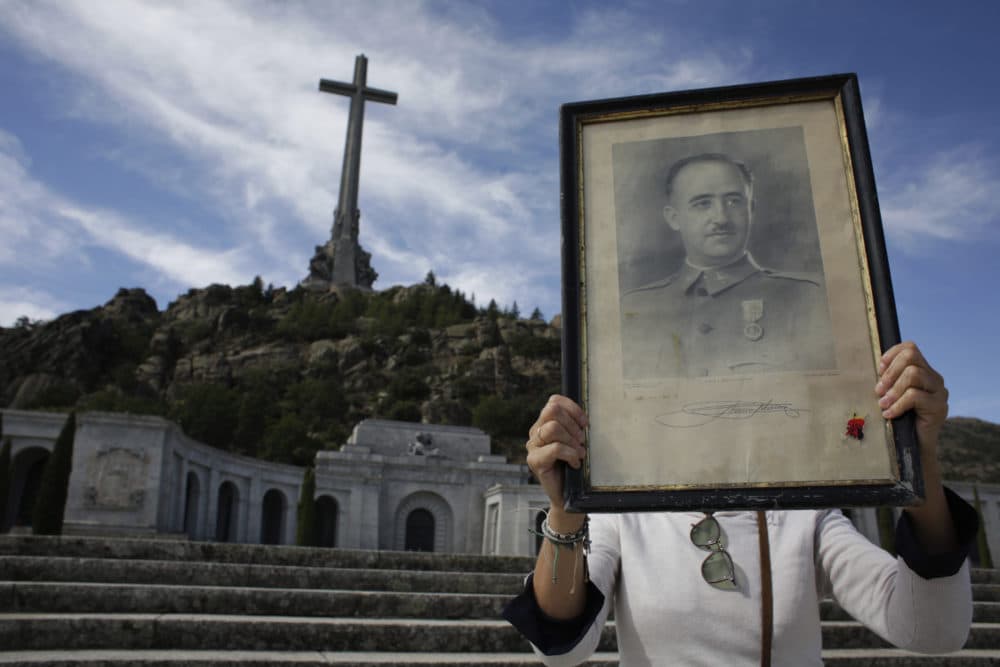Advertisement
Spain Exhumes Former Dictator Francisco Franco's Remains

After nearly 44 years, former Spanish dictator Gen. Francisco Franco's remains were exhumed Thursday from the mausoleum Spaniards call "Valle de los Caídos," a controversial site that has become a shrine of sorts for the far-right and loathed by many Spaniards.
The exhumation comes after a year-long battle between the Socialist government and relatives of Franco.
"Valle de los Caídos," which translates to the Valley of the Fallen, was Franco’s idea, says Sebastiaan Faber, chair of Hispanic studies at Oberlin College.
“He initially conceived of it as a massive mausoleum and monument for those who had fallen on his side of the Spanish Civil War fighting against the Spanish Republic,” Faber says. “Later on, he changed his idea about that and he said it would be for the fallen on any side of the war.”
When Franco died in 1975, the Spanish government buried him in there. The massive monument has served as a “pilgrimage site for those nostalgic of his regime” — also known as the Spanish extreme right.
Faber says the decision to exhume him and move his remains to a cemetery near Madrid where his wife is buried was a political one, fueled by the Socialist Party’s commitment to move Spain away from its Francoist legacy and hold the country accountable for its past wrongdoings.
But this is just the start of Spain addressing historic injustices, he says. For example, the country is looking at the way Germany has transformed former Nazi concentration camps into spaces for education and reflection while leaving them intact.
“This hopefully is what will happen to the Valley of the Fallen in Spain,” he says.
Interview Highlights
On why the monument is important, and the controversy surrounding it
“Well, the Valley of the Fallen was an idea of Francisco Franco himself. Franco came to power in Spain at the end of a three-year civil war that ended in 1939, which he won with the considerable help of Nazi Germany and Fascist Italy and the support of the Vatican, and that initiated a military dictatorship that he would had and that would last until his death in 1975 — so almost 40 years. From the 1950s on, he also had the support of the United States.
“He came up with the idea of the Valley of the Fallen right after the end of the Civil War. … When he had died himself, it was the Spanish government decided to bury him in that same place. Until then, the people buried there included the founder of the Spanish Fascist Party, José Antonio Primo de Rivera y Sáenz de Heredia, and 33,000 or so bodies of victims of battle or other types of violence during the Spanish Civil War. And interestingly, the place hasn't changed really at all since then. In addition to this massive monument, which consists of the basilica ... a massive esplanade, a monastery which still houses a small order of Benedictine monks.”
Advertisement
On the politics behind the exhumation
“It's definitely a political move in the sense that the Socialist Party sees this as an important symbolic gesture to confirm its commitment to move Spain into the 21st century and away from its Francoist legacy. The reason that it took so long has to do with the way in which Spain conceives of its transition to democracy in the late ‘70s. The main idea of the transition was to leave the past, the past, not mess with it and just move ahead into the future.
"Ideas about that started changing around 2000, and it was a previous Socialist government that in 2007 managed to pass a law of historical memory that for the first time really started to process or to come to account with some elements of Spain's 20th century legacy. And that law also included, for example, the stipulation that no longer could official commemorations of Francoism take place at the Valley of the Fallen.”
On whether people can still visit his grave
“To some extent, the new plot is still a public plot. One of the gripes of the left, especially in Spain, has been the fact that the Valley of the Fallen is a public monument. It's maintained with taxpayers' money. The new plot still continues to be a public plot. So the critics say, look, it's OK, they can move in, but it's still going to be taxpayer-funded. It's really not fair to have the victims or descendants of the victims of the Franco dictatorship continue to pay for his burial place so many years after his death and after the end of the regime.
“There are other complaints having to do with the exhumation from the left that say, look, the exhumations, it's an important symbolic gesture, we agree. But it's only really the tip of the iceberg of a long laundry list of other legacies of Francoism that continued to be undealt with that still have to be accounted for. And it's not at all clear whether the Socialist government is willing to go farther than this particular gesture.”
On how modern societies are addressing historical wrongs
“It's kind of tempting to see Spain as a special case. It's a European country that had a military dictatorship well into the 1970s, and that makes this kind of exceptional. It's also tempting to compare Spain to a country like Germany, which in the past half-century has been much more rigorous in the way that it has accounted for the legacies of Naziism. But really, when you think about it, the kinds of questions, the kinds of big questions that Spain is grappling with today have to do with historical justice and what to do with the legacies of historical injustice. And in that sense, a country like the United States has similar kinds of questions to face. The legacies of the Confederacy in the South, what to do with the physical traces of the Confederacy, for example, the statues or even holidays, are important questions that are really likely and that have stirred up contemporary political controversy as we know.
“In the same way that in Spain, one of the legacies of Francoism is socio-economic in the sense that this almost 40 long year dictatorship allowed individuals, families and corporations to amass massive fortunes through their connections to the regime, fortunes that today continue to exist. Even the Franco family is a hugely wealthy family that's never been asked to account for its wealth. And that same way you could say that in the United States, economic questions are also part of this historical justice issue, right? Because the whole discussion about reparations for slavery is ultimately also an economic discussion. And it's complicated enough to know what to do with the statues and monuments and holidays. It's even more complicated how to properly account for present legacies of past injustices if they're economic in nature, because it really goes to one of the main questions, which is what is the responsibility of present generations for past injustices that they didn't themselves commit, whose results and legacies they continue to either suffer or enjoy.
“But what is good to see is that both Spain and some groups in the United States are really trying to learn from each other and to look at examples elsewhere in the world as potential roads to get to a more just situation. A good example, I think, is the memorial to lynching that went up last year in Montgomery, Alabama, through the Equal Justice Initiative headed by Bryan Stevenson, which very consciously looks at countries like Germany as a model to think about how the United States might deal with its legacies of racial injustice.”
Cristina Kim produced this story and edited it for broadcast with Todd Mundt. Serena McMahon adapted it for the web.
This segment aired on October 24, 2019.
